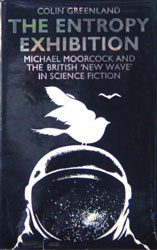
The Entropy Exhibition
Colin Greenland
244 pages, including notes and index
published in 1983
As somebody who started to read science fiction long after the New Wave had been and gone, it always surprises me how controversial it still can be even today. I have had several discussions with people who still reject it out of hand and think science fiction has never been the same since. I have some sympathy for this point of view, but on the whole I think the New Wave helped open science fiction up and break out of the pulp "ghetto". Even if the ghetto was pretty comfortable for a long time.
The New Wave started in 1964 with Michael Moorcock and New Worlds, when the former became the editor of the latter. Young, brash and talented, he wanted to do Everything Different and succeeded, with the help of two other maverick British sf writers, J. G. Ballard and Brian Aldiss. All three were unnsatisfied with the state of science fiction as it then existed. It wasn't relevant, it was stodgy and unambitious. What they injected into science fiction was a mixture of Literacy, Sex and Relevance.
Of course, as with all revolutions it wasn't long before their original vision degenerated into shock for shock's sake and a backlash appeared. As such it made it difficult to evaluate the New Wave while it was happening, and it is no wonder that The Entropy Exhibition, the first thorough examination of the New Wave, was only published some twenty years after the fact.
Colin Greenland is these days better known as a science fiction novelist, but based on this book, he apparantely started out as a sf critic. The Entropy Exhibition is his attempt at writing a critical appreciation of the British New Wave, as it formed around New Worlds magazine. This was not attempted as a general history of the New Wave, but deliberately limited its scope to New Worlds and its core writers according to Greenland: Brian Aldiss, J. G. Ballard and Michael Moorcock. The American New Wave is only mentioned in passing.
Greenland starts by putting the New Wave in context, dedicating one short chapter each to the social landscape of England in the early sixties and the history of New Worlds before Moorcock became its editor. He then spends three chapters detailing the central obsessions of at least the British New Wave: Sex (or taboo), the rejection of traditional sf concerns, especially space travel and "innerspace". Each chapter is richly illustrated with extracts from New Worlds stories of various writers.
After this general overview, Greenland then focuses on what he argues are the three core writers of the New Wave: Brian Aldiss, J. G. Ballard and Michael Moorcock himself. Each in their own way were misfits within science fiction before the wave struck: Aldiss came from a traditional literary background, Moorcock had been an editor at age 16 and had written more stories before his 20th than a lot of people do in their whole life and Ballard always had done his own thing. It's typical that none of them stayed "just" science fiction writers, but branched out (or in the case of Aldiss returned) to more mainstream literature. Each of them started out influenced by post-modernism as it was in the early sixties, by writers like William Burroughs, who showed them that they didn't have to adhere to outmoded conventions, but could use avant garde tehcniques in science fiction.
Finally, in the third and most difficult part of the book, Greenland lets loose a hefty dose of literary theory on the whole New Wave. It is in these chapters that Greenland puts together his theory of the New Wave: that, as the title of the book shows, it is all about coming to terms with Entropy. This is the central paradox of the British new Wave movement: "the conviction that form is degenerating and energy dissipating, asserted with remarkable formal resourcefulness and an energy of expression so compelling we may well call it exhibitionist". Freed from the rigeurs of genre, authors still need to struggle with the fact that everything can and will decay. But even this decay, as Moorcock has shown in his Jerry Cornelius can be exhilarating, liberating.
In all, The Entropy Exhibition made for an interesting read, which I can recommend to anyone interested in science fiction as a literary genre, even if you do not agree about its conclusions or even the importance of the New Wave. The Entropy Exhibition is surprisingly relevant even now, some twenty years after first publication and some forty years after the New Wave first started. It seems in some ways science fiction has ever since tried to refute its central message.
One minor annoyance with this book was the way quotes were being presented, just by slightly indenting the lines, leaving no whitespace between quotes and the rest of the text. This made it harder to read then it needed to be. Greenland's writing in itself is fairly dense at times as well.
